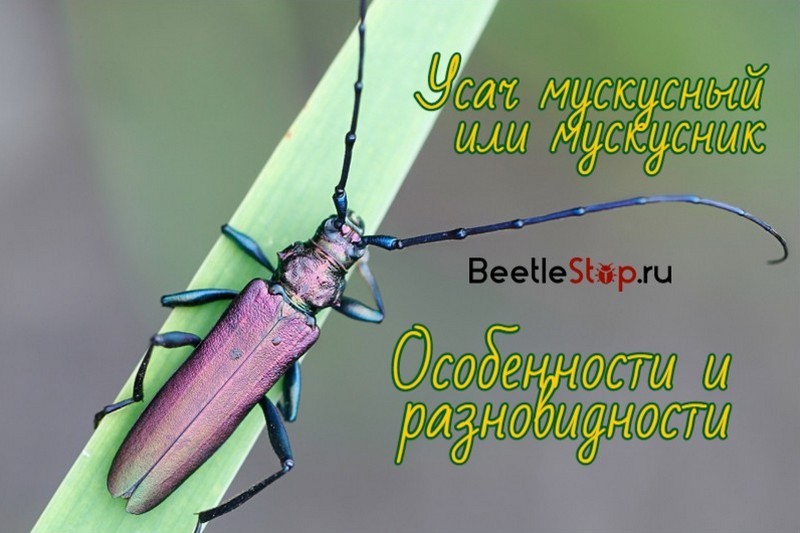Musk barbel - a bug with variable color and a specific smell
The family of barbel or lumberjack is distinguished by a huge variety of species. Its representatives can be found on almost all continents. The large, beautifully colored musky barbel beetle lives in the Palearctic. On the winged body there are aromatic pores, with the help of which a smell close to musky is spread. Adults are active all summer, fly over flowers and feed on umbrella plants. Larvae develop up to three years under the bark of willow or poplar.

View description
The barbel is musky or musk (Aromiamoschata) - one of 26 thousand species of the family of barbel. The body length of the imago is 38 mm. There are individuals with different color options for elytra: green, copper, blue. Any color has a characteristic metallic tint. Scientists studying beetles have found many differences in their color and body structure. Muskusnikov was divided into 8 subspecies and 20 aberrations.
The color of the imago is monophonic or with red spots on the pronotum. In some cases, the color of the antennae and limbs is different from the main background. Adult head in grooves and punctures. Eyes of facet type, emarginate. Antennae segmented, starting from the fourth segment, a longitudinal groove appears. First segment thickened, shorter than third in length.
Information. Sexual dimorphism of beetles manifests itself in the length of the antennae. In males they are longer than the elytra, and in females they reach the end, sometimes protruding.
The pre-tympanum is transverse, equally narrowed to the head and base. The shield is convex, covered with wrinkled punctures, large spiky tubercles on the sides. Pronotum glabrous, separate small hairs along edges. Elytra elongated, their dyne 4 times the width. The puncture is small, but dense, in some forms there are longitudinal ribs.
Odor release mechanism
Representatives of the species Aromiamoschata have a specific protective mechanism - in case of a threat, they emit a pungent odor. In the belly of beetles there is a metasternal gland that produces secretions with rosenoxide. Gaping aromatic pores are located on the back of the imago. Through the excretory openings hidden behind the coxae, a musk-like odor is released. This feature defined the species name moschata - “musk".
Variability
The vast geographical distribution and different climatic conditions in the habitats led to differences in the sculpture of beetles. Such changes are characteristic of subspecies. Aberrations or color changes occur in the same geographic region within the same subspecies.
Subspecies
- Aromiamoschataambrosiaca is distributed in southern Europe (Greece, Sicily, Italy, Spain) and northern Africa (Algeria, Morocco). The body of the beetle is 17-38 mm; the color of the elytra and scutellum is red. Pronotum covered with folds and wrinkles.
- Aromiamoschatacruenta - beetles live in Central Asia. Legs and flap are red.
- Aromiamoschataorientalis - insects are found in the East Asian region. Pronotum red, elytra green.
- A. m. jankovskyi is a rare subspecies found in Kyrgyzstan. Body color is dark, with a metallic tint. The length of the imago is 32-33 mm. The antennae and legs are blue-green.
- A. m. mochata - beetles inhabit Europe, Kazakhstan, China. The size of the imago is 13-34 mm; pronotum is in large punctures. The limbs are black with a blue tint.Elytra dark, covered with blue or green hairs.
- A. m. sumbarensis - habitat - Turkmenistan, length 32 mm. The chest of the beetle is green with a metallic sheen.
- A. m. thoracica - Middle Eastern subspecies from Turkey, Lebanon, Iran. The limbs and antennae are black, the shield is red, the elytra is green.
- Aromiamoschatavetusta - barbel people inhabit the lower reaches of the Syr Darya river in Kazakhstan. Antennae blue, legs with reddish patches. The main color of the elytra is golden.
Distribution area
Musk barbel is called the trans-Palaearctic species. Insects live throughout Europe, in part of Asia, located north of the Himalayas, in the Caucasus, in Siberia, Japan. In the north, distribution is limited to the taiga zone. In the south passes through the northern part of Africa. On the territory of Ukraine and Latvia, musk barbel is listed in the Red Book as a vulnerable species.
Information. In 2007, two new musk subspecies were found and described in Kyrgyzstan and Turkmenistan - a. m. jankovskiy and a. m. sumbarensis.
Beetle lifestyle
Favorite habitats of the willow plantation beetle on coastal sections of rivers. The imago years last from May to October. Barbel need additional nutrition, which they get from the nectar of umbrella plants, woody excretions, juice of found fruits. After feeding, adults begin to mate.
To continue the genus, beetles fly over trees where larvae will develop. Fodder plants are various species of willow, aspen, alder, chestnut, poplar. The female lays eggs in the lower part of the trunk, hiding them under the bark. Her fecundity is 25 eggs. Development takes 2-3 weeks.
The appeared larvae lay winding passages in the wood. The body of the larva is bright, the head is reddish-brown. Jaws massive, antennae of four segments. The legs are well developed, there are claws. There are red hairs on the sides of the abdomen. The development of the larva takes 3 years, during which time it grows to 30-40 mm. For pupation, she gnaws the area under the crib. The doll is located upside down. Its length is 25-35 mm.
Malware
Musk barbel is a pest of trees. Insect larvae spoil the living wood of willow, poplar and aspen. Periodically, outbreaks of mass reproduction occur, which last up to 9 years. At such sites, reconnaissance and detailed surveillance of the stem pest is carried out. Affected trees are identified by wet spots on the bark and the remnants of drill flour. Preventive forestry measures are carried out against muskets, and in difficult cases, sanitary cutting.

